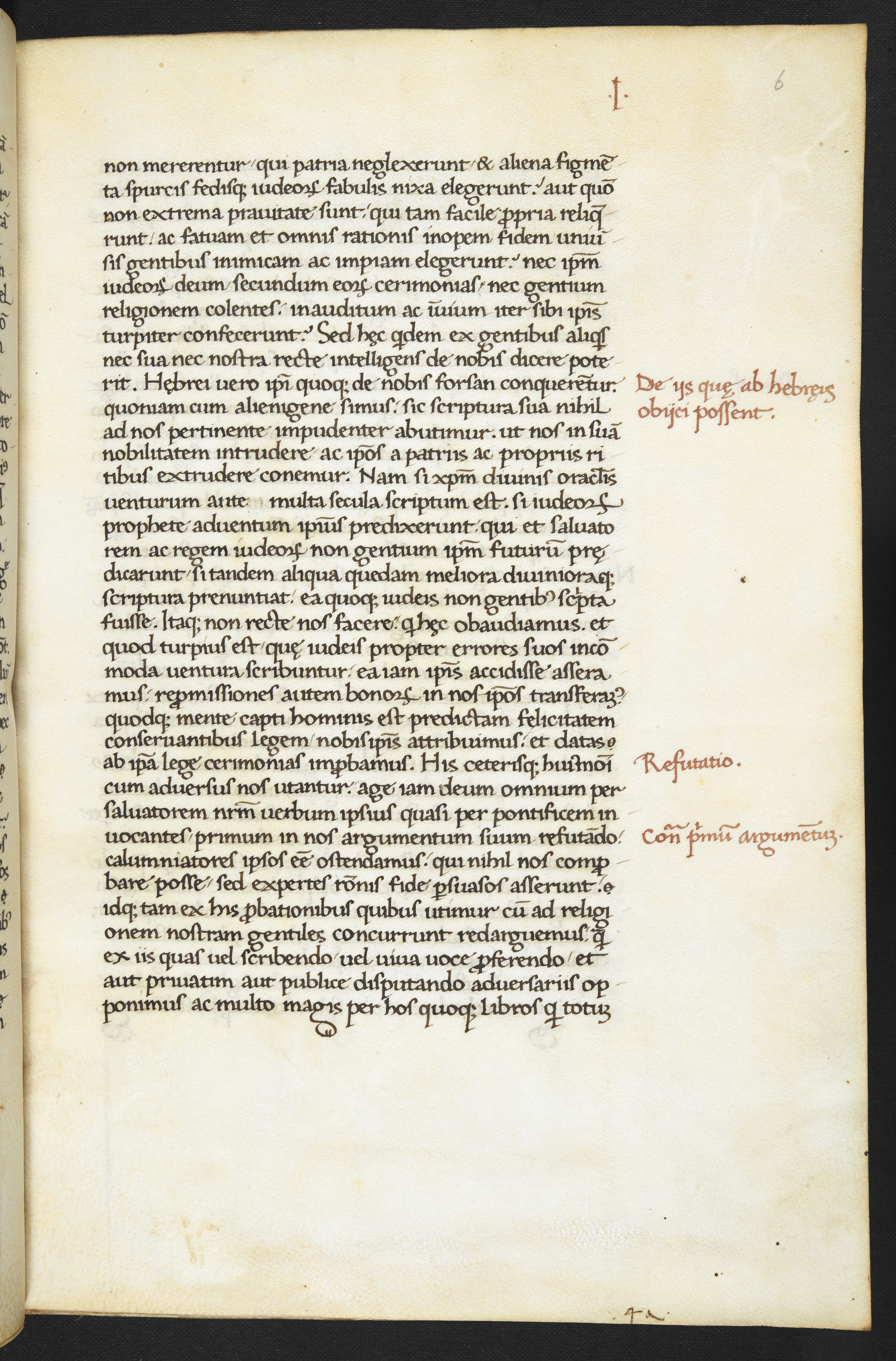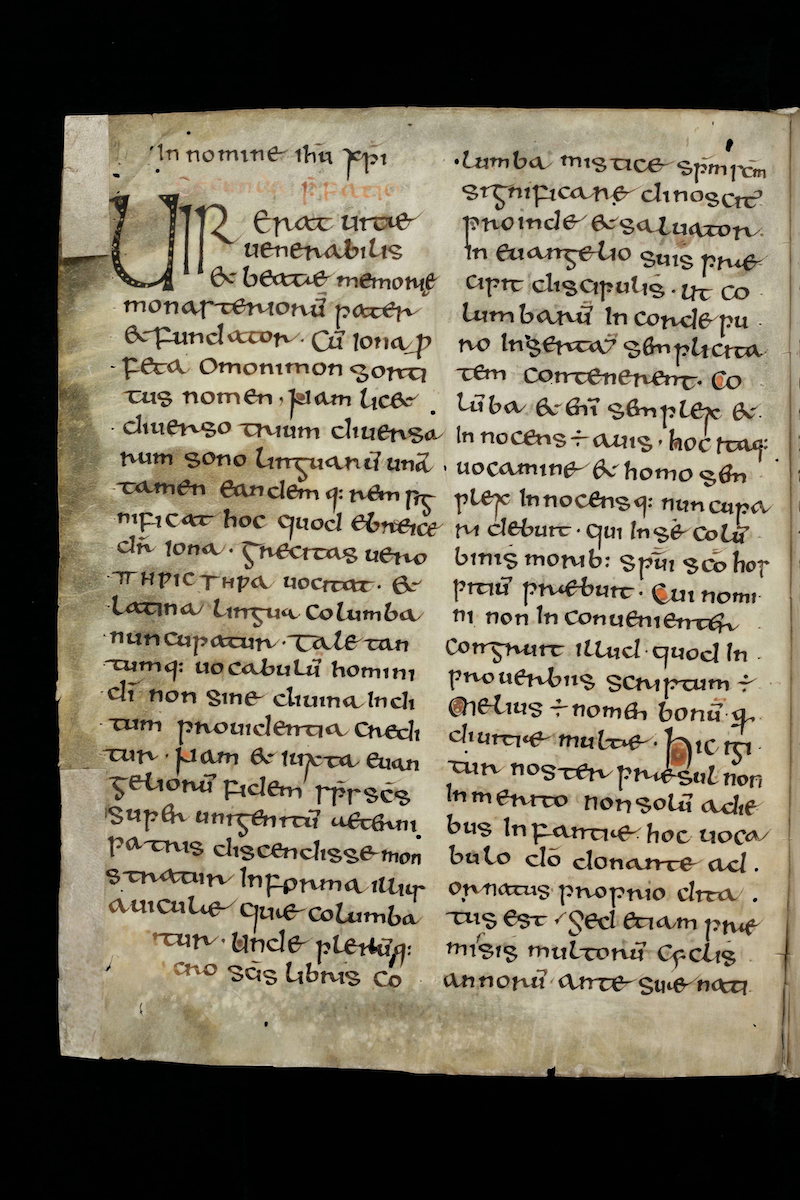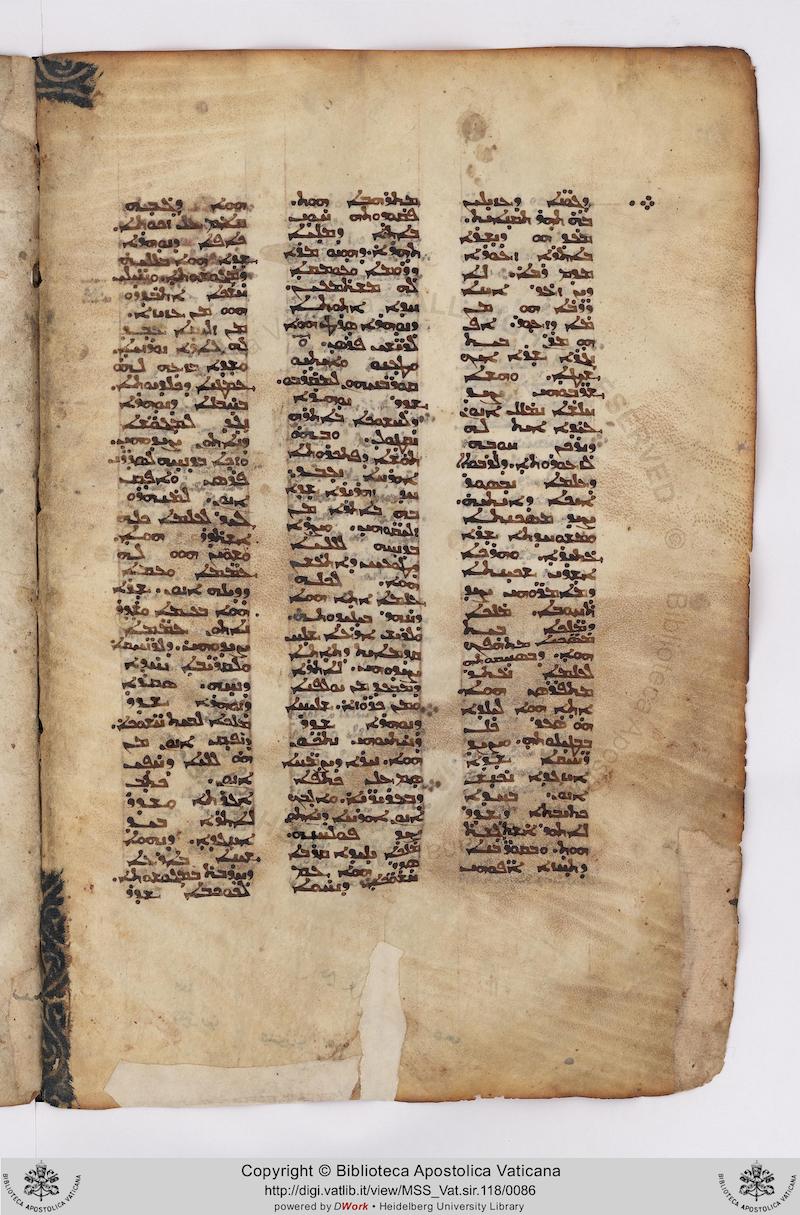
Humanist Minuscule; Humanist Cursive, 15th century
-
Title
Eusebius of Caesarea, De evangelica praeparatione, translated by George of Trebizond -
Text
Book I, Chapter 2 -
Language(s)
Latin -
Writing System
Roman -
Script(s)
Humanist Minuscule; Humanist Cursive -
Country
Great Britain -
City
London -
Repository
British Library -
Shelf Mark
Harley 3477, fol. 6r -
Century
15th century -
Year Range
1460-1460 -
Date Precise
1460 -
Place Of Origin
Italy, Rome -
Bibliography
Andrew G. Watson, Catalogue of Dated and Datable Manuscripts c. 700-1600 in The Department of Manuscripts: The British Library, 2 vols (1979), no. 756.
Cyril Ernest Wright, Fontes Harleiani: A Study of the Sources of the Harleian Collection of Manuscripts in the British Museum (1972), p. 162.
A Catalogue of the Harleian Manuscripts in the British Museum, 4 vols (1808-12), vol. 3, no. 3477.
This elegant 15th-century manuscript does an outstanding job of imitating the layout features of the Carolingian manuscripts that were the inspiration for the Humanists' reform of script. The long lines, squarish proportions of the written area, and generous margins are all Carolingian, not Gothic features. The nearly-invisible ruling helps preserve the open look of the page in the Carolingian style. The scribe, Johannes Mervelt, has imitated the Carolingian practice of beginning the writing above the top ruled line, where Gothic practice was to begin below the top ruled line. The letters sit on the ruled line, rather than floating above it, which is a neo-Carolingian feature that scribes trained in Gothic habits often have a hard time replicating. On the other hand, the script has a large minim-height in proportion to its ascenders and descenders, which tends to minimize the space between lines of writing and lends the written area a density not typical either of Carolingian manuscripts or of the best examples of Humanist script.
The script itself is exceptionally legible. Mervelt has an exuberant way with the Carolingian-style gs, and he observes in almost all places the rule of using tall s at the ends of words (a Carolingian habit not observed by Gothic scribes). He consistently uses the Carolingian & instead of the Gothic Tironian et. A few features of his script betrays his familiarity with contemporary Gothic scribal habits, however: he consistently uses the 2-shaped r with a slash through it after o for the -rum ending of the genitive plural; he uses the -us abbreviation that looks like the top of a question mark; and he occasionally uses m turned on its side at word-end. See the image annotations for examples.
Mervelt uses the punctus and punctus elevatus to set off clauses, but he also uses a hairline slash to punctuate smaller units. These closely resemble his end-of-line hyphens, which he generally remembers to use where he breaks a word at line end.
The text in this manuscript, Eusebius's early-4th-century work, De evangelica praeparatione, sets out to refute arguments that might be made by pagans against Christians for their adoption of Jewish scripture and rejection of Jewish practices. Eusebius was the historian and scriptural scholar whose apparatus for studying the Gospels informs so many of the Gospel manuscripts in the Folio collection. This translation of Eusebius's work into Latin by George of Trebizond was new at the time this copy was made.
Late-medieval scribes included symbols and marginal annotations to help readers find their way around the parts of Eusebius's argument in this text. Here, symbols that look like a θ with a dot underneath mark sections of the argument and are related, though not in a way that is completely apparent on this page, to the marginal annotations. The marginal notes are by the same scribe as the main text writing in Humanist Cursive instead of Humanist Minuscule. They say: Refutatio ("refutation") and Con(tra) p(ri)mu(m) argume(n)tum ("against the first argument").
Acknowledgements: Described by Carin Ruff
Transcription
1 non merentur / qui patria neglexerunt/ et aliena figme(n)-
2 ta spurcis sedisq(ue) iudeor(um) fabulis nixa elegerunt.´ aut quo(niam)
3 non extrema prauitate sunt.´ qui tam facile p(ro)pria reliq(ue)-
4 runt.´ ac fatuam et omnis rationis inopem fidem uniu(er)-
5 sis gentibus inimicam ac impiam elegerunt.´ nec ip(su)m
6 iudeor(um) deum secundum eor(um) cerimonias/ nec gentium
7 religionem colentes.´ inauditum ac i(n)uium iter sibi ip(s)is
8 turpiter confecerunt.´ Sed hȩc q(ui)dem ex gentibus aliq(ui)s
9 nec sua nec nostra recte intelligens de nobis dicere pote-
10 rit. Hȩbrei uero ip(s)i quoq(ue) de nobis forsan conquere(n)tur.
11 quoniam cum aliegene simus.´ sic scriptura sua nihil
12 ad nos pertinente impudenter abutimur. ut nos in sua(m)
13 nobilitatem intrudere/ ac ip(s)os a patriis ac propriis ri-
14 tibus extrudere conemur. Nam si chr(istu)m diuinis orac(u)lis
15 uenturum ante[m] multa secula scriptum est. si iudeor(um)
16 prophete aduentum ip(s)ius predixerunt.´ qui et saluato(-)
17 rem ac regem iudeor(um) non gentium ip(su)m futuru(m) prȩ-
18 dicarunt/ si tandem aliqua quedam meliora diuinioraq(ue)
19 scriptura prenuntiat.´ ea quoq(ue) iudeis non gentib(us) sc(ri)pta
20 fuisse. Itaq(ue) non recte nos facere.´ q(ui) hȩc obaudiamus. et
21 quod turpius est/ quę iudeis propter errores suos inco(m)-
22 moda uentura scribuntur.´ ea iam ip(s)is accidisse assera(-)
23 mus.´ rep(ro)missiones autem bonor(um) in nos ip(s)os transferam(us).´
24 quodq(ue) mente capti hominis est predictam felicitatem
25 conseruantibus legem/ nobis ip(s)is attribuimus.´ et datas θ
26 ab ip(s)a lege cerimonias imp(ro)bamus. His ceterisq(ue) hui(us)mo(d)i
27 cum aduersus nos utantur.´ age iam deum omnium per
28 saluatorem n(ost)r(u)m uerbum ipsius quasi per pontificem in-
29 uocantes/ primum in nos argumentum suum refuta(n)do.´
30 caliumnatores ipsos e(ss)e ostendamus.´ qui nihil nos comp(ro)-
31 bare posse/ sed expertes r(ati)onis fide p(er)suasos asserunt.´ θ
32 idq(ue) tam ex his p(ro)bationibus quibus utimur cu(m) ad reli-
33 onem nostram gentiles concurrunt redarguemus.´ q(uam)
34 ex iis quas uel scribendo/ uel uiua uoce p(ro)ferendo/ et
35 aut priuatim aut publice disputando aduersariis op-
36 ponimus ac multo magis per hos quoq(ue) libros q(ui) totum
Paleographic Features
1. At the upper left corner of the written area, you can just make out the fact that the writing starts above the top ruled line, which is almost invisible, and the letters sit on the line rather than floating above it. These are Carolingian layout techniques imitated by Humanist scribes.
2. The 2-shaped r used following round letters like o, and the vertical stroke through the tail of the r for the -um of the -rum abbrevation, are both Gothic scribal habits. Mervelt has a particularly exuberant, tall, s-like abbreviation stroke, which you can see on iudeor(um) in the middle of line 2.
3. gs are very personal to individual scribes. Mervelt's interpretation of the Caroline/Humanist g appears in both the minuscule main text (for example in elegerunt, line 2) and the cursive marginal annotations (argume(n)tum, in the bottom-most marginal note).
4. Mervelt usually remembers to use a tall s at word end, in the Carolingian manner, as in spurcis in line 2.
5. Line 15: An m has been erased after ante. It seems likely that Mervelt began to write the following multa without leaving space between words. It is possible that the error was caused by an exemplar in which word separation was less good than in the present copy, though there are other possible explanations for the error.
6. Line 19, second word from the end: The abbreviation for -us on gentib(us) is a Gothic habit that Mervelt carries over into his Humanist script.
7. The last word in line 23, transferamus, ends with an m turned on its side so it looks like a 3 followed by the superscript curve -us abbreviation. Both are wholly Gothic features.
8. The θ symbol at the end of lines 25 and 31 marks portions of the argument and is probably related to the marginal notes nearby.



